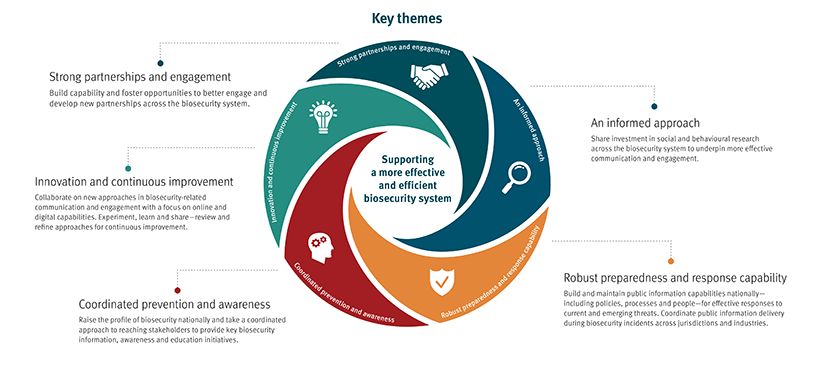Publication detail
November 2020.
Download
| Document | Pages | File size |
|---|---|---|
National Biosecurity Communcation and Engagement Strategy PDF |
2 | 2.0 MB |
If you have difficulty accessing this file, visit web accessibility for assistance.
Online version
Why is this strategy important?
Effective communication and engagement underpins our ability to improve biosecurity outcomes by influencing behaviour change, promoting partnerships, supporting new initiatives and providing accurate and timely information during incidents. This strategy highlights where we can build communication and engagement capacity and capability across government, industry and the community.
What do we want to achieve?
Our goal is a collaborative and coordinated national approach to communication and engagement. Stronger connections and better information delivery will build a more effective and efficient biosecurity system.
Key themes
Strong partnerships and engagement
Build capability and foster opportunities to better engage and develop new partnerships across the biosecurity system.
Innovation and continuous improvement
Collaborate on new approaches in biosecurity-related communication and engagement with a focus on online and digital capabilities. Experiment, learn and share, review and refine approaches for continuous improvement.
Coordinated prevention and awareness
Raise the profile of biosecurity nationally and take a coordinated approach to reaching stakeholders to provide key biosecurity information, awareness and education
An informed approach
Share investment in social and behavioural research across the biosecurity system to underpin more effective communication and engagement.
Robust preparedness and response capability
Build and maintain public information capabilities nationally, including policies, processes and people, for effective responses to current and emerging threats. Coordinate public information delivery during biosecurity incidents across jurisdictions and industries.
Who will be part of our success?
Delivery of this strategy will rely on the collaboration of communication, education and engagement professionals across government, industry and other biosecurity-related organisations, at both state and national levels. The National Biosecurity Communication and Engagement Network (NBCEN) will play a key coordination role across each jurisdiction and member organisation.
How will we achieve results?
Strong partnerships and engagement
Engage industry and government through national committees and networks. Promote national workshops and events that foster engagement, including jurisdictional partners’ forums, round tables and the Australian Biosecurity Symposium. Ensure best practice in biosecurity partnerships and share and profile successes through national networks. Develop partnerships at a jurisdictional level with key organisations that can champion biosecurity, such as science centres.
Strategy in action
The Australian Biosecurity Symposium is a national partnership initiative between Animal Health Australia, Invasive Species Council and the Centre for Invasive Species Solutions that brings together government and industry to collaborate on current biosecurity challenges.
Innovation and continuous improvement
Share successes in digital and social media approaches used to improve biosecurity outcomes. Maintain and promote the biosecurity web portal and outbreak website. Track and expand national digital and social media capabilities and footprints. Seek out new and emerging communication and engagement approaches that have biosecurity applications. Capture learnings from the COVID-19 pandemic to help shape our approach to biosecurity communication and engagement.
Strategy in action
NBCEN is currently coordinating approaches to social media use in relation to biosecurity issues on online trading sites to improve biosecurity surveillance and compliance.
Coordinated prevention and awareness
Collaborate on, and promote, national key messaging and the national narrative to raise biosecurity’s profile. Coordinate prevention campaign opportunities nationally with a particular focus on grassroots and high-risk biosecurity issues, behaviours and audiences. Coordinate and deliver campaigns around emerging threats such as xylella and African swine fever. Develop and maintain a national image library of priority pests and diseases.
Strategy in action
Mission Biosecurity is a grassroots awareness and behaviour change campaign fronted by Costa Georgiadis and focused on high-risk biosecurity issues. The initiative has been led by the New South Wales Government and funded and developed in partnership with other state government agencies and the Australian Government.
Robust preparedness and response capability
Maintain and refine the national Biosecurity incident public information manual, ensuring robust policies and procedures. Deliver biosecurity public information training and development opportunities for both government and industry. Coordinate public information response planning for priority and emerging pests and disease. Ensure effective public information delivery, including national talking points, during biosecurity incidents. Learn from biosecurity incident response experiences for continuous improvement.
Strategy in action
A formal registered training package for biosecurity incident public information managers has been finalised. The package was delivered to the National Biosecurity Response Team’s public information officers for the first time in late 2019.
An informed approach
Collaborate on social and behavioural research projects to maximise reach and outcomes. Share behavioural research findings and learnings to underpin biosecurity approaches and campaigns. Share outcomes of stakeholder engagement and consultation activities around key biosecurity initiatives and challenges. Foster strong connections across national committees and work groups to support effective communication and information-sharing.
Strategy in action
Plant Health Australia hosts a national biosecurity behavioural research portal where government, industry and other stakeholders can share and access current research outcome.
This strategy has been prepared by the National Biosecurity Communication and Engagement Network (NBCEN) and endorsed by the National Biosecurity Committee.

